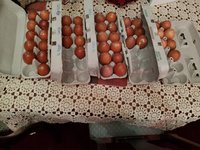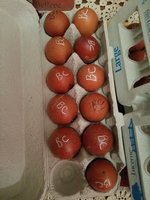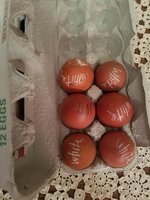So is it best to cull any with white in the wing feathers? Is it best to do this in the young too? I am looking at these young Blue Coppers. I know they should lose the white as they get older but is it best to not use them.Here is white underfluff under a cull's hackle and parasitic white of the wing. This bird would be DQ in show.
View attachment 1470292 View attachment 1470293
You have to look closely at the underfluff of birds. White is usually easily spotted, but light grey underfluff can be mistaken for white.
Navigation
Install the app
How to install the app on iOS
Follow along with the video below to see how to install our site as a web app on your home screen.
Note: This feature may not be available in some browsers.
More options
You are using an out of date browser. It may not display this or other websites correctly.
You should upgrade or use an alternative browser.
You should upgrade or use an alternative browser.
International Black Copper Marans Thread - Breeding to the SOP
- Thread starter Red Banks
- Start date
So is it best to cull any with white in the wing feathers? Is it best to do this in the young too? I am looking at these young Blue Coppers. I know they should lose the white as they get older but is it best to not use them.
Once a bird has reached maturity at around 6-8 months old, meaning a female has reached laying age and the males are crowing/mating and all mature feathers have fully come in that is when I would cull for white (if you have other birds of good quality to choose from with no white). Mature primaries are rounded on the ends, juvenile primaries are pointed on the ends. I wouldn't cull juvenile birds for white, as most juveniles will have some white in the primaries. White primaries in juveniles molt out and usually the mature primaries come in black (or blue in the case of blue birds).
However, I like to see very minimal white in the wings of my juveniles. I am happy if I only see 1 white feather in each wing and even happier if there is no white in the juveniles' wings. Most juveniles will have some white though. Some of my juveniles have anywhere from zero to 4-5 white primaries in each wing. I don't like seeing very many white feathers in my juveniles just as a personal preference as it seems to correlate with carrying white and showing up in the adult plumage. I am still testing that theory. I do document how much white juveniles have in their wings, and I even document how much white they have on their faces and down as chicks as I am wing banding them.
The set of feathers that the birds develop as they reach sexual maturity at around 6-8 months old are the set that they will have until their adult molt. The first adult molt typically occurs at around 12-18 months or so. Most breeders I have talked to cull birds that show white at 6-8 months old, because more than 1/2 half inch of positive white on any one feather or more is a DQ. They cannot show the birds, nor do they wish to breed the DQ further. If a bird has nice qualities otherwise, I have been advised to pull a white feather if one is found by 8 months old and see if it comes back in black. I will be testing that theory and will post back with my results.
I will also note that if a bird is exceptional in other aspects and has a white feather, if mated to a bird that does not have the same fault the bird could still be worked with. White is a fault just like any other and can be improved upon. I would only cull a bird that showed white if I had better birds to use in place of them. My favorite hen, Queen has one white primary feather. She has the best type of any other Marans hen I have. I wouldn't dream of throwing that away. When you have the luxury to cull for white, that is one thing. But don't throw out an otherwise good bird for one white feather. That is my 2 cents.
I hope they don't sit outside on a dock somewhere. I think the trucks and offices are probably air conditioned. I hope!
I hope so too but literally shipped eggs are a total crap shoot. I received 2 dozen white legbar eggs (26 eggs actually), out of those I set 25 because 1 was busted. ZERO hatched. From the same breeder I received 12 more eggs as replacements and 7 white legbars ended up hatching with 1 cream legbar bonus chick (even though within days of hatching I lost 3 WL chicks). So 0/25 the first set and 8/12 the second set. From the same breeder, from the same pen of chickens within just weeks of each shipment.
I'm hoping you have a terrific hatch rate! I know Harvey's birds are amazingly healthy and vigorous from the pictures I've seen, so hopefully the post workers go easy on them during shipping.

Lately every time I have had eggs shipped. They have been scrambled. I am thinking of putting them in directly after they arrive and just not turn them for a couple days. I am not really sure what is the best way to go about hatching. I read where if it is hot it could start the incubation process. Praying for the eggs to come in good shape and get a good hatch.I hope so too but literally shipped eggs are a total crap shoot. I received 2 dozen white legbar eggs (26 eggs actually), out of those I set 25 because 1 was busted. ZERO hatched. From the same breeder I received 12 more eggs as replacements and 7 white legbars ended up hatching with 1 cream legbar bonus chick (even though within days of hatching I lost 3 WL chicks). So 0/25 the first set and 8/12 the second set. From the same breeder, from the same pen of chickens within just weeks of each shipment.
I'm hoping you have a terrific hatch rate! I know Harvey's birds are amazingly healthy and vigorous from the pictures I've seen, so hopefully the post workers go easy on them during shipping.
Lately every time I have had eggs shipped. They have been scrambled. I am thinking of putting them in directly after they arrive and just not turn them for a couple days. I am not really sure what is the best way to go about hatching. I read where if it is hot it could start the incubation process. Praying for the eggs to come in good shape and get a good hatch.
Here is what I do. If it is hot out and I have had eggs shipped during that hotter months I set them as soon as they come but I put them in the bottom of the incubator in the egg rack and not in the turner just in case they have begun developing during shipping. I do not turn for a full 48 hours. After that I put them in the turner and treat them as I would any other egg. If you have a styrofoam incubator with an auto turner just leave the turner off for 48 hours, then plug it in after that time.
If the temps have been cooler, I unpack the eggs and put them into the egg rack and let them sit at room temp to let them warm up before setting them. Never set cold eggs. If I unpack them in the evening, I will set later on that night or early the next morning. Then I treat them the same as above, I don't turn for a full 48 hours. After that I treat them as I would any other egg.
Okay the experiment has begun. I just pulled out the 2 white feathers in Jupiter's wing. I was going to butcher him, just because I have 3 other cockerels I am keeping that don't have white primaries. But for the sake of experimenting, we will keep him around. For reference, the feathers were located in his right wing. One white feather was a primary, the other was a covert.
Magnolia Hill
Songster
Keep us posted, where has everyone been hiding?Okay the experiment has begun. I just pulled out the 2 white feathers in Jupiter's wing. I was going to butcher him, just because I have 3 other cockerels I am keeping that don't have white primaries. But for the sake of experimenting, we will keep him around. For reference, the feathers were located in his right wing. One white feather was a primary, the other was a covert.
I have a stubborn broody hen so I decided to let her have a few of the Marans eggs. I think I have her 6. There's no guarantee that they're pure but if they are, maybe I'll get more girls 

Once a bird has reached maturity at around 6-8 months old, meaning a female has reached laying age and the males are crowing/mating and all mature feathers have fully come in that is when I would cull for white (if you have other birds of good quality to choose from with no white). Mature primaries are rounded on the ends, juvenile primaries are pointed on the ends. I wouldn't cull juvenile birds for white, as most juveniles will have some white in the primaries. White primaries in juveniles molt out and usually the mature primaries come in black (or blue in the case of blue birds).
However, I like to see very minimal white in the wings of my juveniles. I am happy if I only see 1 white feather in each wing and even happier if there is no white in the juveniles' wings. Most juveniles will have some white though. Some of my juveniles have anywhere from zero to 4-5 white primaries in each wing. I don't like seeing very many white feathers in my juveniles just as a personal preference as it seems to correlate with carrying white and showing up in the adult plumage. I am still testing that theory. I do document how much white juveniles have in their wings, and I even document how much white they have on their faces and down as chicks as I am wing banding them.
The set of feathers that the birds develop as they reach sexual maturity at around 6-8 months old are the set that they will have until their adult molt. The first adult molt typically occurs at around 12-18 months or so. Most breeders I have talked to cull birds that show white at 6-8 months old, because more than 1/2 half inch of positive white on any one feather or more is a DQ. They cannot show the birds, nor do they wish to breed the DQ further. If a bird has nice qualities otherwise, I have been advised to pull a white feather if one is found by 8 months old and see if it comes back in black. I will be testing that theory and will post back with my results.
I will also note that if a bird is exceptional in other aspects and has a white feather, if mated to a bird that does not have the same fault the bird could still be worked with. White is a fault just like any other and can be improved upon. I would only cull a bird that showed white if I had better birds to use in place of them. My favorite hen, Queen has one white primary feather. She has the best type of any other Marans hen I have. I wouldn't dream of throwing that away. When you have the luxury to cull for white, that is one thing. But don't throw out an otherwise good bird for one white feather. That is my 2 cents.

@kwhites634 this may answer your question about white feathers on your BCMs.
They are here! There are 43 eggs total. 11- BC = Blue Copper
7- Bls= Blue Silver Cuckoo's
7 - lines are Blue Birchen
18- wh = White
Harvey said they have lightened being this late in the season. They still have good color. They must have been super dark! My camera always lightens. They look even darker in real life.



7- Bls= Blue Silver Cuckoo's
7 - lines are Blue Birchen
18- wh = White
Harvey said they have lightened being this late in the season. They still have good color. They must have been super dark! My camera always lightens. They look even darker in real life.



New posts New threads Active threads
-
Latest threads
-
-
Question about bantam weight on treadle feeders…
- Started by Bantam bell Wood
- Replies: 0
-
-
-
-
-
Threads with more replies in the last 15 days
-
-
-
-
-
Ended BYC Poultry Caption Contest 08-15-25 Pic by rural mouse
- Started by TwoCrows
- Replies: 50
-
×




